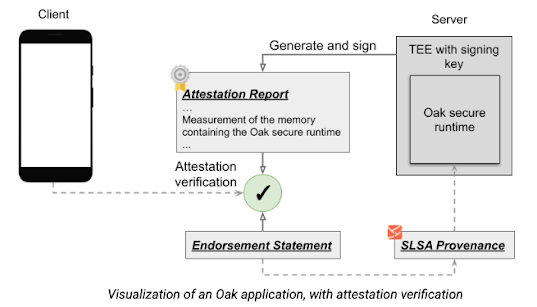Asra Ali, Razieh Behjati, Tiziano Santoro, Software Engineers
Every day, personal data, such as location information, images, or text queries are passed between your device and remote, cloud-based services. Your data is encrypted when in transit and at rest, but as potential attack vectors grow more sophisticated, data must also be protected during use by the service, especially for software systems that handle personally identifiable user data.
Toward this goal, Google’s Project Oak is a research effort that relies on the confidential computing paradigm to build an infrastructure for processing sensitive user data in a secure and privacy-preserving way: we ensure data is protected during transit, at rest, and while in use. As an assurance that the user data is in fact protected, we’ve open sourced Project Oak code, and have introduced a transparent release process to provide publicly inspectable evidence that the application was built from that source code.
This blog post introduces Oak’s transparent release process, which relies on the SLSA framework to generate cryptographic proof of the origin of Oak’s confidential computing stack, and together with Oak’s remote attestation process, allows users to cryptographically verify that their personal data was processed by a trustworthy application in a secure environment.
Integrity and transparency with SLSA
Project Oak recently collaborated with the SLSA community to create a new container-based builder that produces Supply-chain Levels for Software Artifacts (SLSA) Build Level 3 provenance. This new container-based builder generates non-forgeable provenance statements that capture details about build process information that allow users to perform automated, rigorous provenance verification.
With this enhanced provenance generated by the container-based builder, you can answer questions like:
Was the artifact built with a toolchain that I know and trust?
Was the artifact built with a command that I trust?
Did the build command use a tool that was affected by a vulnerability?
How can I recreate the artifact?
Project Oak is particularly interested in answering these questions about every layer of the confidential computing stack. For instance, to be sure that a released binary was built using a trusted build process (e.g., the build command did not use any potentially malicious tool), the Oak release process compares the build command against a set of allow-listed tokens. Similarly, we can verify that the builder was not tampered with.
Transparent releases: an added layer of trust
Project Oak develops a secure runtime and a remote attestation protocol—ways to detect potential adversaries on remote servers and to protect workloads while they are running. Now, with the addition of the container-based SLSA builder, we are able to complete our transparent release process to protect against software supply chain attacks and provide an automated process for verifying the integrity and trustworthiness of a remote server, before sending sensitive information to it.
Specifically, for each released version of the Oak secure runtime, the Oak team generates and signs an endorsement statement for the binary, using a key accessible only to the Oak team. The endorsement statement can only be generated if the provenance statement passes verification checks, ensuring that a potential malicious attacker cannot forge the statement.
When the client establishes a connection to the server, the client must verify the endorsement statement and the proof of its inclusion in a transparency log, and check that the binary identities in the attestation report and the endorsement statement are the same. This, together with signature verification for the endorsement statement, guarantees three important points of trust for the overall process: that the client is interacting with the same publicly endorsed version of the Oak secure runtime that all other clients interact with; the Oak secure runtime is open source; and that it has a publicly published non-forgeable SLSA v1.0 provenance with adherence to SLSA Build Track 3. For a more technical explanation of the process, see Project Oak’s transparent release process.
Visualization of an Oak application, with attestation verification
Try it out
We encourage you to check out the transparent release project as a use case for SLSA. Please reach out to us via our slack channel to explore ideas related to Oak secure runtimes and remote attestation.
You don’t need to use Project Oak to take advantage of the new SLSA builder tool. If your project is open source, try one of the SLSA builders to generate non-forgeable provenance for your binaries. We encourage you to containerize your build and try the container-based SLSA 3 builder! Using a container image for your builds improves the reproducibility of your binaries. We also recommend adding the instructions for building your container image (e.g., a Dockerfile) to your GitHub repository, which improves auditability and transparency of your build process, and thus the security of your software supply chain.
Article Link: Google Online Security Blog: Bringing Transparency to Confidential Computing with SLSA
